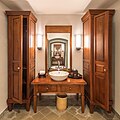| Amantaka | |
|---|---|
| | |
 | |
| General information | |
| Location | 55/3 Kingkitsarath Road, Ban Thongchaleun, Luang Prabang, Laos |
| Coordinates | 19°53′34″N102°8′21″E / 19.89278°N 102.13917°E |
| Opening | September 2009 |
| Owner | Aman Resorts |
| Management | Tshewang Norbu (General Manager) |
| Other information | |
| Number of rooms | 24 |
Amantaka is a luxury hotel in Luang Prabang, Laos. The hotel, located in a French colonial building, is operated by Aman Resorts and opened in September 2009. The hotel is located in the northwestern part of the city in the old town area, several metres from the Mekong River and approximately 400 metres northeast of the Royal Palace. The hotel encourages the education of the guests in traditional Lao culture and hires such cultural advisers to teach the guests on a regular basis in traditional Lao customs and practices. [1] Originally completed in 1923 as the Viceroy family residence of Prince Boun Khong, Amantaka’s Aman Villa is situated in close proximity to Amantaka, allowing guests easy access to all the resort’s facilities. [2]


















